Custom Domain Name
Last Updated on : 2024-11-01 07:27:41download
Currently, the mobile app and the paired devices initiate network requests using a Tuya-specific domain name by default. The Custom Domain Name service allows you to set up a custom domain for your app. Once a domain name takes effect, the network requests from the app that the domain name applies to and the devices that are paired with the respective app will be directed to your domain.
There are three approaches to configuring a custom domain name for different business needs.
Tuya Domain Name Service
Overview
Tuya purchases your preferred domain name, completes the required configurations, and manages the purchased domain name on your behalf. The whole process is simple and requires minimal future maintenance. If you want to manage and maintain the domain name by yourself, you can request Tuya to transfer it to you at any time.
Applicability
You can easily complete the configuration with minimal or no knowledge of domain and DNS. The future maintenance is managed by Tuya. This approach is recommended due to its low costs and risks.
In compliance with regulations, Tuya Domain Name Service is only available for domain names outside mainland China.
Procedure
-
Choose Tuya Domain Name Service.

-
Click Agree and Continue.
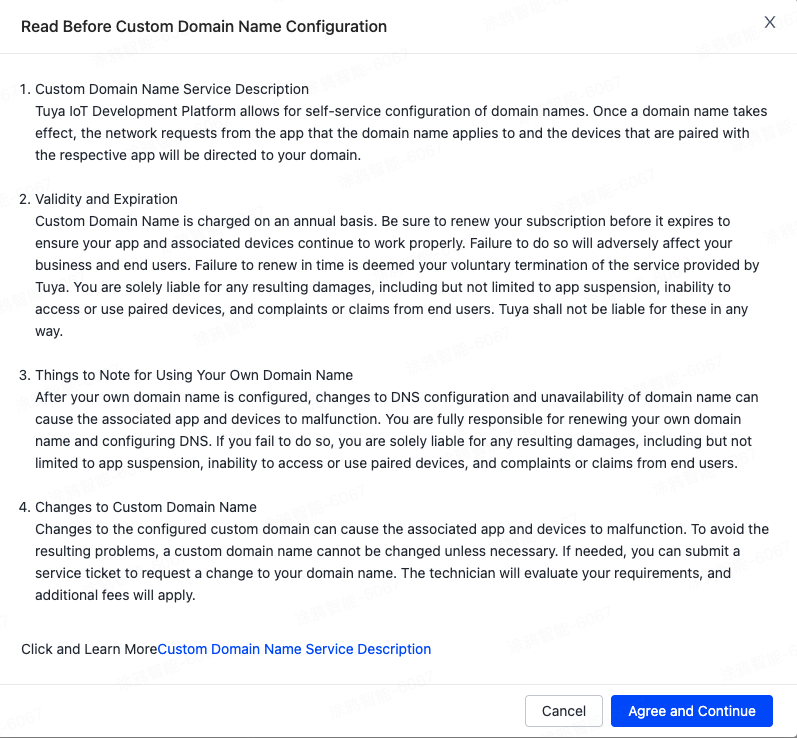
-
Click Select Available Domain Name.
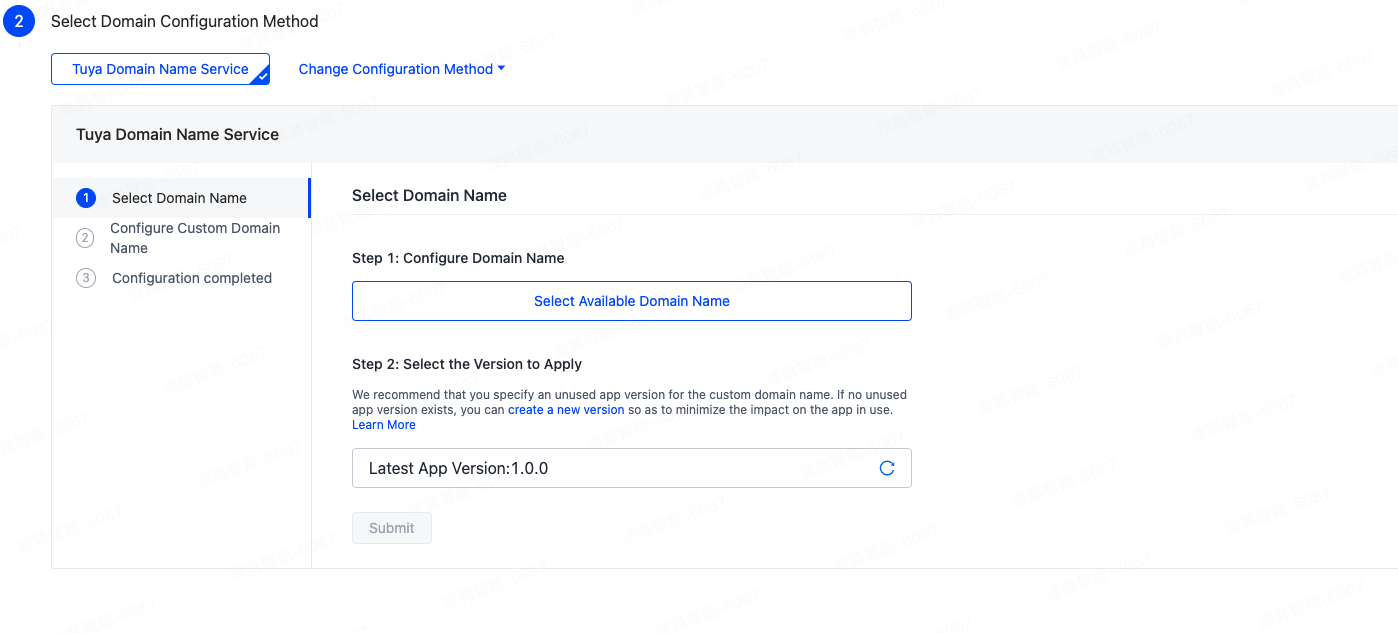
-
Enter a keyword to search for domain names and choose one.

-
The domain name configuration is expected to be completed within 2 to 3 working days. After the domain name is configured, rebuild your app to take effect.

-
After the configuration is finished, a page will appear where you can renew your service as needed.
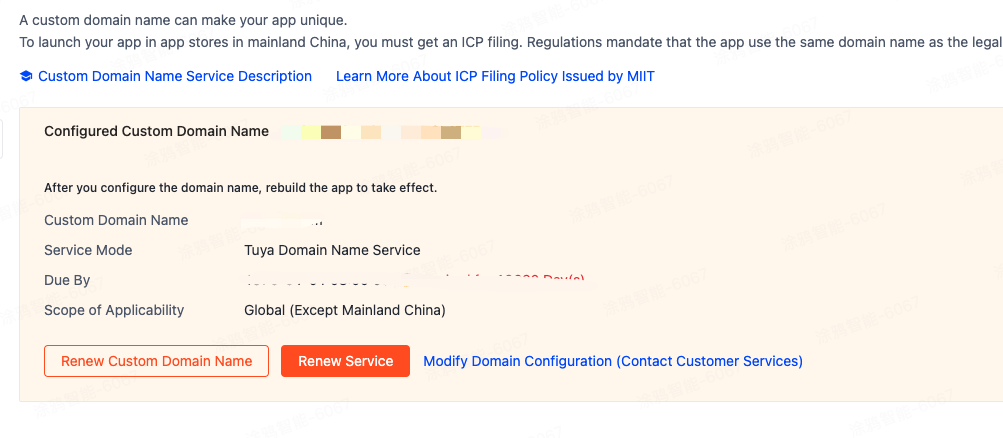
-
Finally, go back to the Get SDK page, rebuild the SDK, and package the effective custom domain name configuration into the SDK development kit.

DNS Hosting
Overview
Set the DNS of your domain name to Tuya’s DNS server address so that your app can use your own domain. Since the domain name is under your control, note the following:
- Tuya has no permission to manage and configure the domain name on your behalf, so you need to take care of the DNS configuration.
- Making changes to the domain name configuration can cause errors that impact the network services of your app and devices. Tuya cannot verify the accuracy of your domain configuration before your domain takes effect, but can only monitor the network for anomalies afterward. Therefore, be sure to set the domain name correctly.
- Remember to renew your domain name before it expires to avoid any network errors.
DNS Hosting only supports top-level domains. After hosting, your original domain name resolution will no longer work. It is recommended to host a domain name that has not been configured.
Applicability
Compared to Tuya Domain Name Service, DNS Hosting is more complex and carries higher risks, so it is only recommended for apps launched in mainland China. Chinese regulations mandate that all apps to be launched in app stores in mainland China must use the same domain name as the legal entity it belongs to. You must use your own domain for the app to be rolled out in mainland China.
Procedure
-
Choose DNS Hosting and click Select This Method.
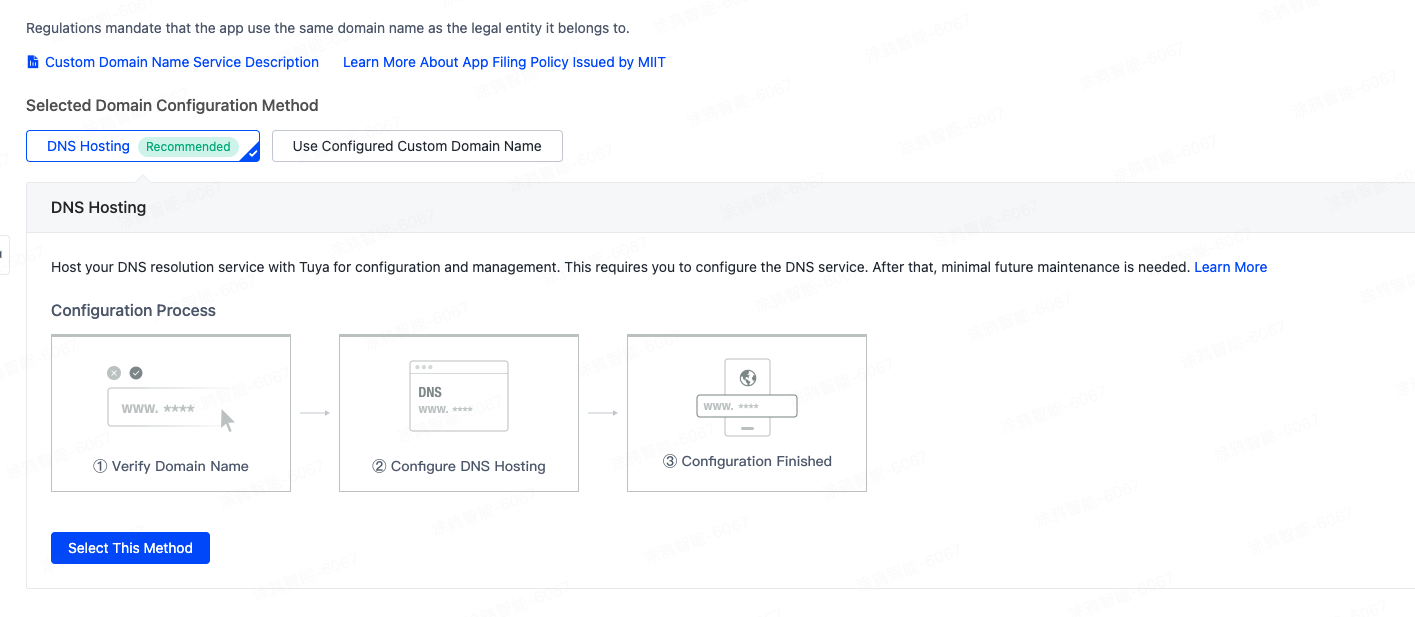
-
Click Agree and Continue.
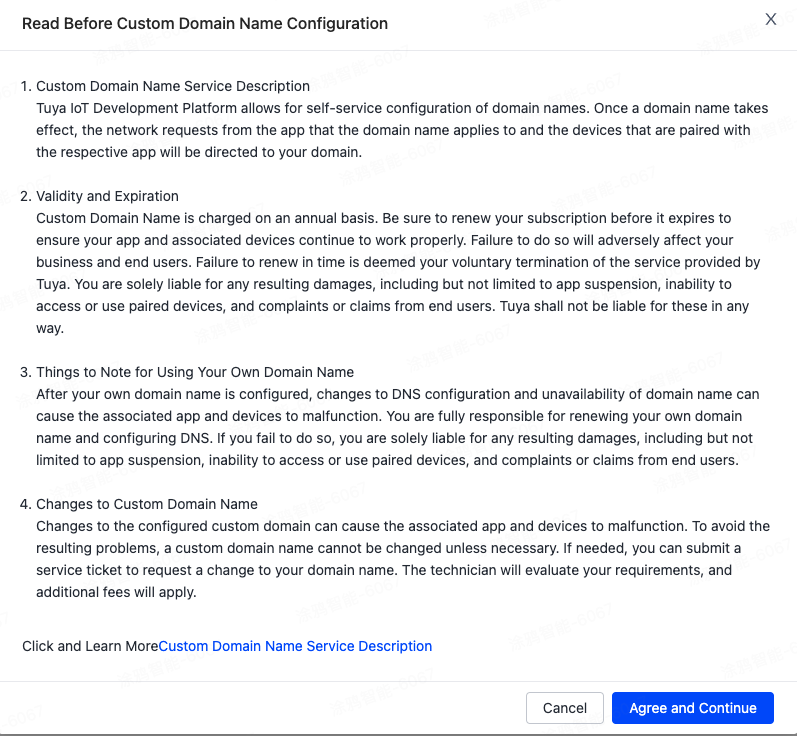
-
Enter your top-level domain.
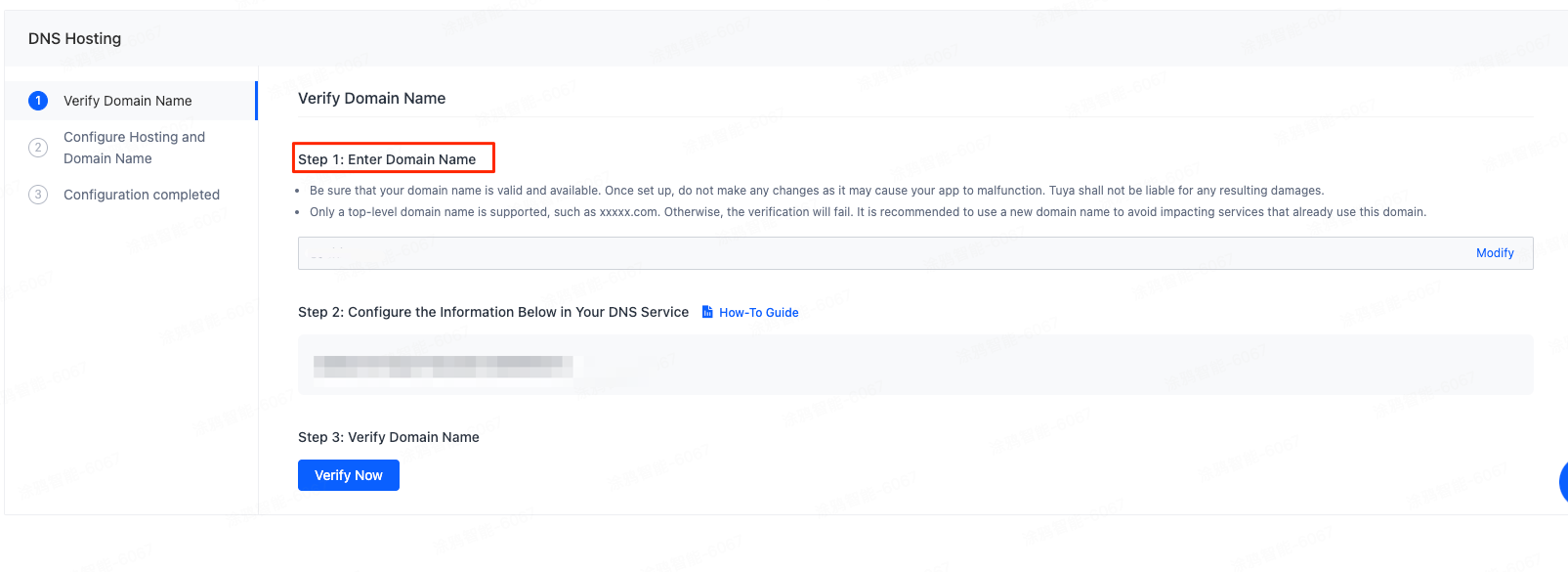
-
Configure the generated information in your DNS service.
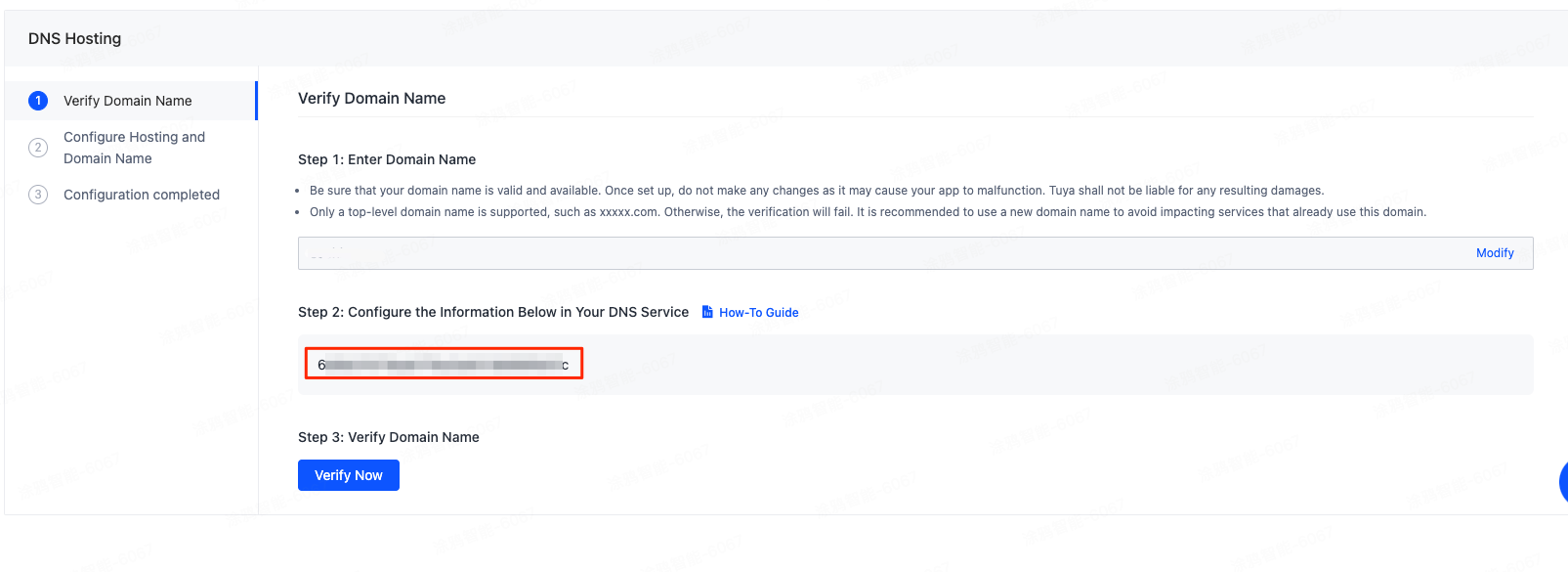
-
Navigate to your DNS provider and open the DNS settings. This section uses Alibaba Cloud as an example to describe the process.

-
On the DNS Settings page, click Add DNS Record.

-
In the panel that appears, specify the following parameters:
-
Record Type: Select TXT.
-
Hostname: Enter @.
-
DNS Request Source: Select Default.
-
Record Value: Enter the information generated on the Tuya IoT Development Platform.
-
TTL Period: Select 10 Minutes.
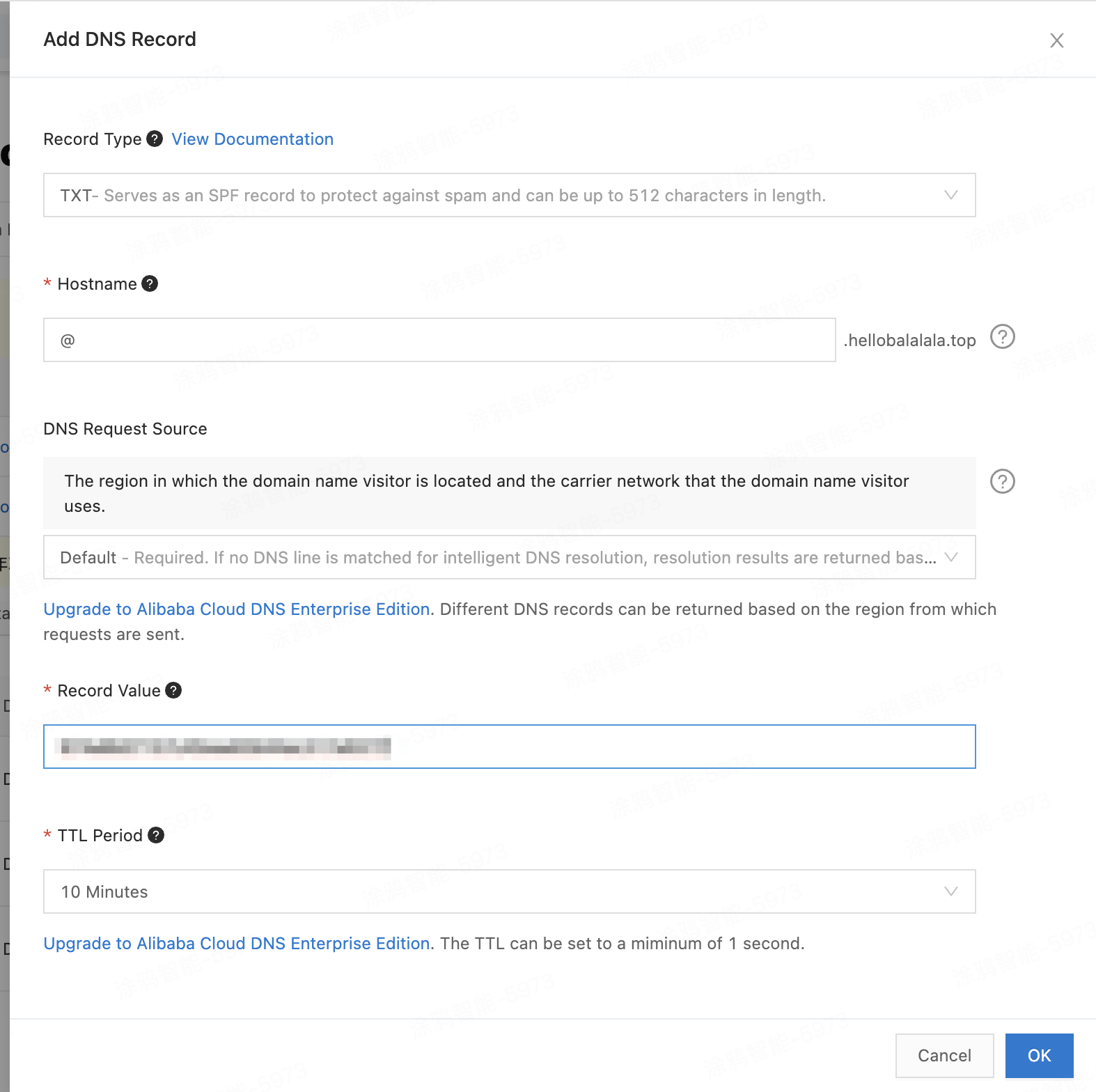
-
-
Click Verify Now. The DNS resolution record might take up to 10 minutes to become effective. If the verification fails to pass within 10 minutes, review the configuration from the previous step.
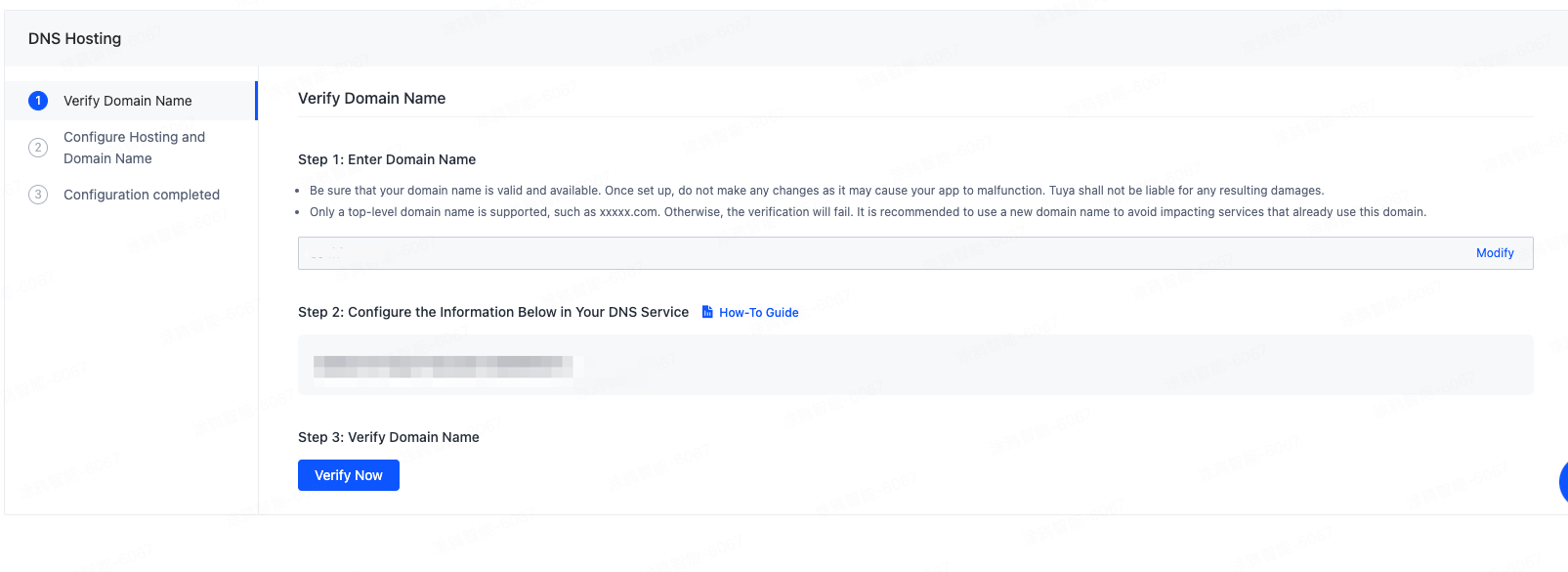
-
Proceed to the next step Configure Hosting and Domain Name.

-
Navigate to your DNS provider and find the target domain name. Click Manage.

-
In the left-side navigation pane, click DNS Server Change. Change the DNS server’s IP addresses to the ones generated on the Tuya IoT Development Platform.
Delete the original DNS information (save it before deleting) and only keep the Tuya-specific DNS information.

-
Click Start Domain Name Configuration, which can take about 30 minutes to finish.
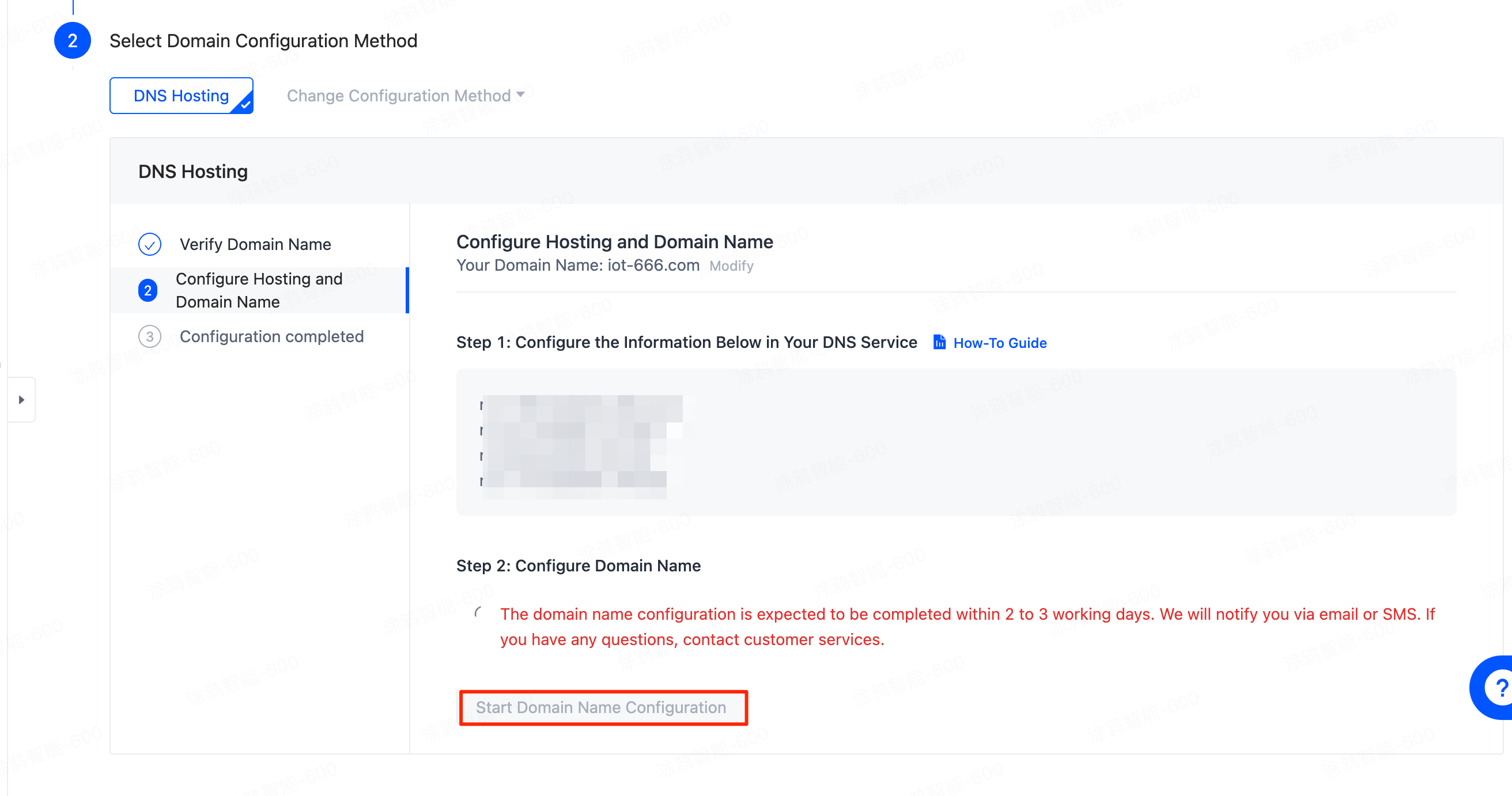
-
After the configuration is finished, a page will appear showing the expiration date of both the domain and service.
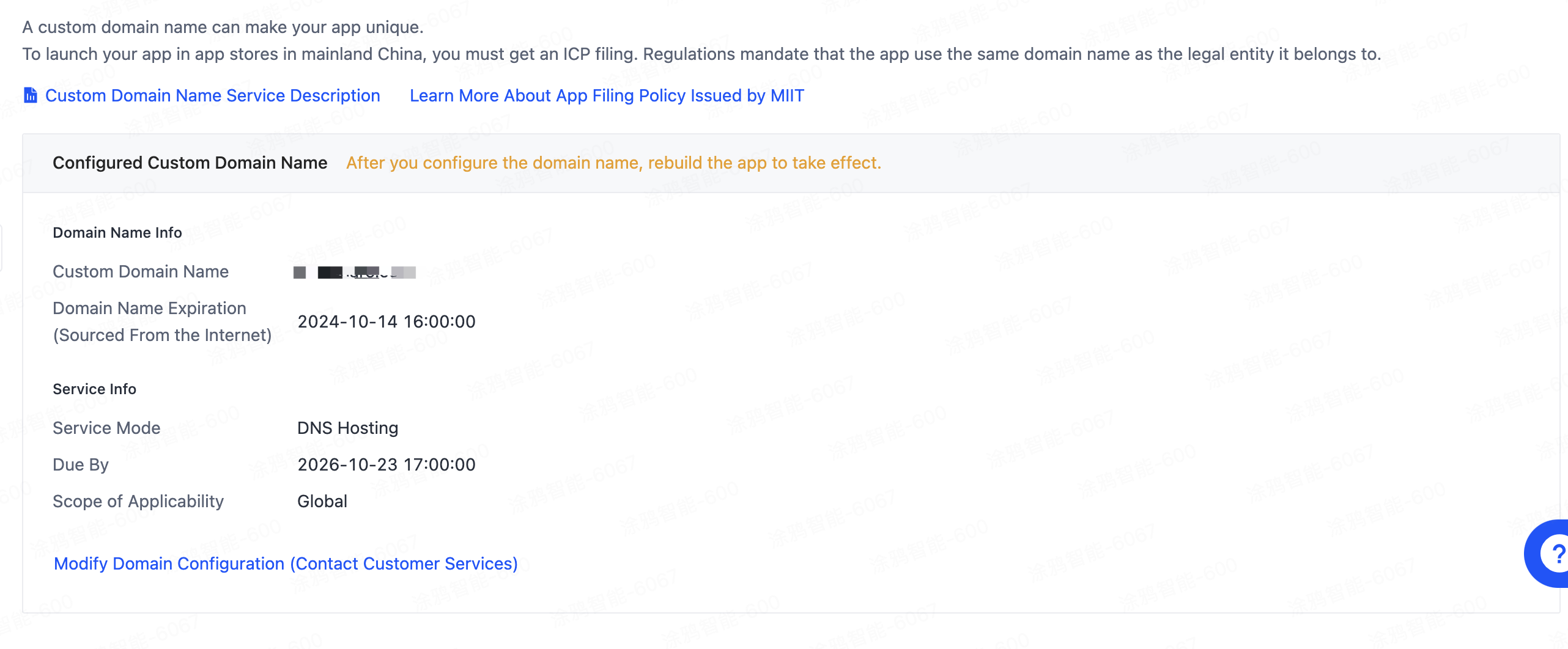
-
Finally, go back to the Get SDK page, rebuild the SDK, and package the effective custom domain name configuration into the SDK development kit.

Share Existing Domain Name
Overview
Apply the same custom domain name to multiple apps. This can help you reduce the cost of purchasing and maintaining multiple domain names. It is important to note that when a domain name expires, all apps and devices associated with it will not work properly.
Currently, you can only share a custom domain name across apps under the same IoT Development Platform account. Regional restrictions also apply. For example, the domain Tuya purchases on your behalf cannot be shared with an app to be launched in mainland China.
Applicability
If your organization operates multiple apps and wants to avoid maintaining separate domain names for each app, this approach is recommended.
Procedure
-
Select Use Configured Custom Domain Name.
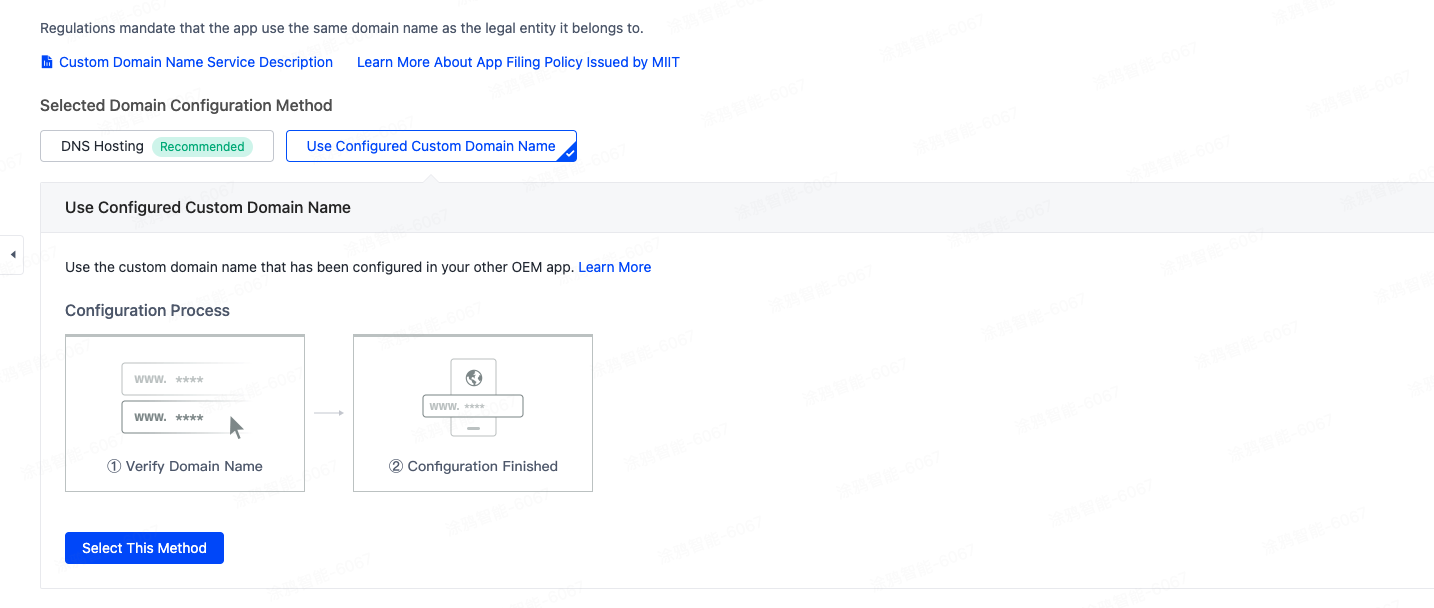
-
Enter a valid custom domain name that has been configured for a different app and click OK.

-
After the configuration is finished, you should see a page like this:
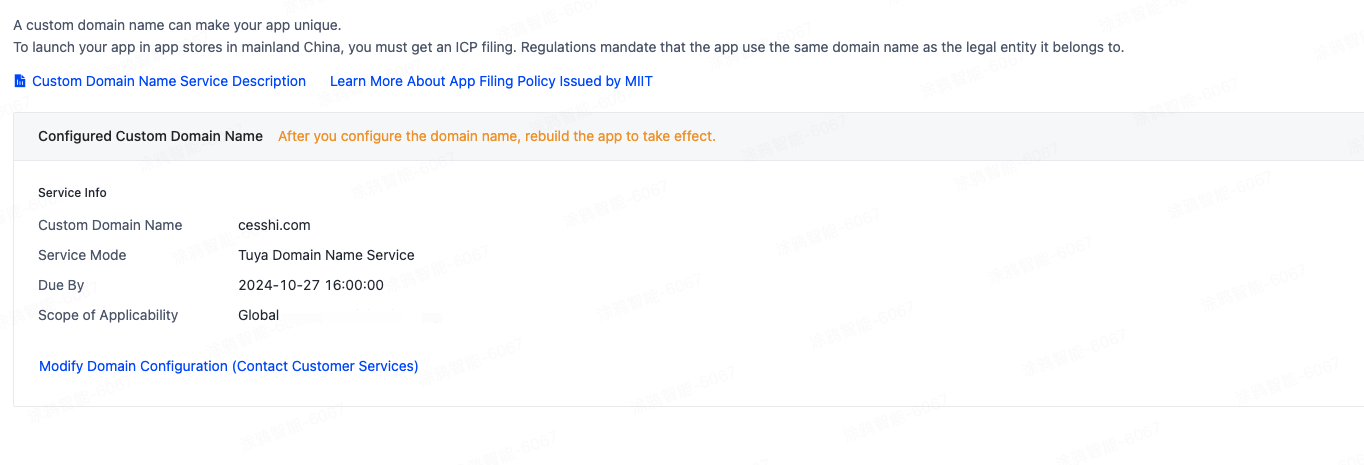
-
Finally, go back to the Get SDK page, rebuild the SDK, and package the effective custom domain name configuration into the SDK development kit.

To configure a custom domain name for SDKs of global version, you need to select the scope of launch, either App stores outside mainland China only or Global app stores including mainland China.

- If you select App stores outside mainland China only, Tuya Domain Name Service, DNS Hosting, and Share Existing Domain Name are applicable. Tuya Domain Name Service is recommended.
- If you select Global app stores including mainland China, DNS Hosting and Share Existing Domain Name are applicable. DNS Hosting is recommended.
Currently, the Tuya IoT Development Platform does not support modifying the configured custom domain name. Review your configuration carefully before submitting. If you make any modifications, the process can be complex and may interrupt your ongoing services. Additional fees will apply. If you have this requirement, submit a ticket.
Things to note
Custom domain name takes effect
After a custom domain name is configured, rebuild your app to take effect, and your app cannot be reverted to using a Tuya-specific domain name.
Effect on the live app
Configuring a custom domain name does not affect your app that is live. It will not make user-facing changes.
Validity and expiration
The Custom Domain Name service is charged on an annual basis. Expiration can cause the associated app and devices to malfunction. Remember to renew your services in time to ensure uninterrupted continuity.
If you use your own domain name (such as DNS Hosting), take care of the renewal of your domain.
If you fail to renew your domain in time, you are solely liable for any resulting damages, including but not limited to app suspension, inability to access or use paired devices, and complaints or claims from end users.
Is this page helpful?
YesFeedbackIs this page helpful?
YesFeedback





